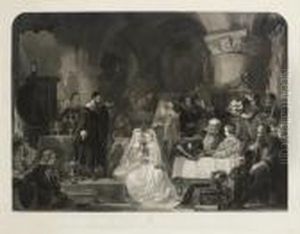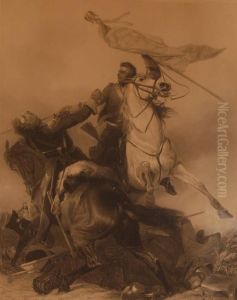Henry Thomas Ryall Paintings
Henry Thomas Ryall was an esteemed English engraver and portraitist, renowned for his contributions to the art of engraving in the 19th century. Born in 1811 in Frome, Somerset, Ryall developed an early interest in the arts, showing remarkable talent that would later define his career. His journey into the world of art began under the guidance of notable figures of the time, which helped hone his skills and establish his path as an artist.
Ryall's career took a significant turn when he moved to London, where he immersed himself in the vibrant artistic scene of the capital. He quickly gained recognition for his exquisite engravings, which were characterized by their intricate detail and the ability to capture the essence of his subjects. Ryall specialized in historical and portrait engravings, often working from paintings by renowned artists of the era. His works were highly sought after, and he became the royal engraver to Queen Victoria, a position that cemented his status as one of the leading engravers in England.
Throughout his career, Ryall produced a vast array of engravings, many of which were published in prestigious publications and collected by art enthusiasts across Europe. His ability to translate the grandeur and subtlety of paintings into engravings contributed significantly to the popularization of the works of contemporary and classical artists. Ryall's dedication to his craft and his innovative techniques left a lasting impact on the art of engraving, influencing generations of artists.
Despite his success, Ryall faced financial difficulties later in life, partly due to the changing tastes in art and the advent of photographic processes that challenged traditional engraving. He died in 1867, leaving behind a legacy of artistic excellence and a body of work that continues to be celebrated for its beauty and precision. Ryall's contributions to the field of engraving and his role in the art world of the 19th century remain significant, commemorating him as a pivotal figure in the history of English art.

